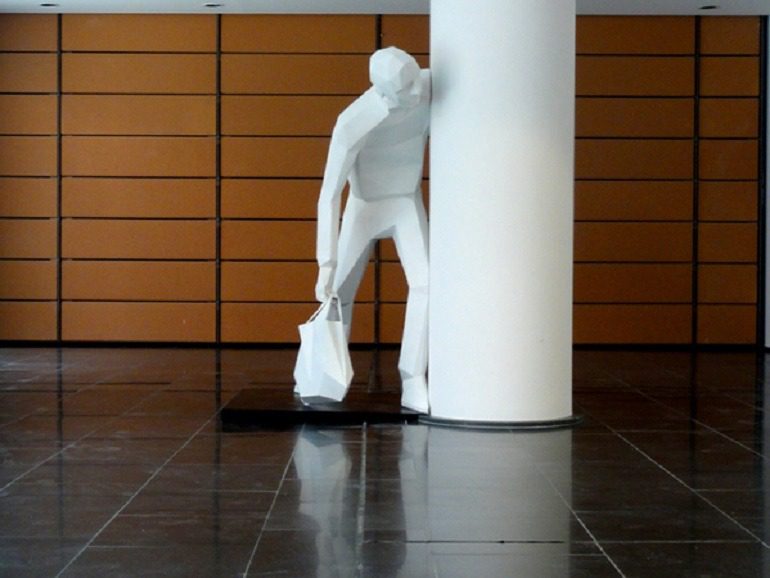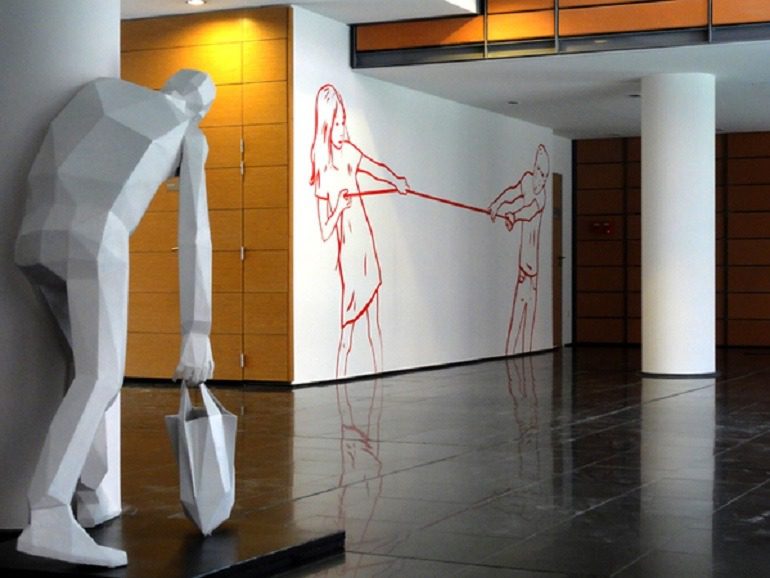ART PROJECTS
David Mesguich, Installation view of the sculpture of Palestinian worker in the exhibition at RX gallery on the lookout in the hallway, Paris, 2009. Image courtesy of the artist.
ART PROJECT: The Israeli-Palestinian conflict continues despite all efforts to curtail it. David Mesguich‘s sculpture of a Palestinian worker sneaking across the Israeli borderline is a reminder of an unresolved gruesome conflict.
BY KAZAD

BRUSSELS, BELGIUM –For more than a decade, the Israel-Palestine crisis has gone unresolved. It takes a tiny spark for missiles, rockets, and stones to start flying in both directions. During these conflicts, innocent Israelis and Palestinians are killed: men, women, and children.
Israel airstrikes in retaliation for missiles fired by Hamas, the Palestinian militant group, are particularly devastating. Buildings are destroyed and in some instances, unconventional weapons like white phosphorus bombs are deployed. The Israeli army has also carried out ground war offensives inside Palestine.
Since he became the United States Secretary of State, Senator John Kerry has resumed the effort to bring the Palestinians and Israelis back to the negotiating table. Taking over from where Hillary Rodham Clinton, Senator Kerry seems determined to succeed where others have failed. From talking to Mahmoud Abbas, President of the Palestinian National Authority to Benjamin Netanyahu, Prime Minister of Israel, the new discussions are a source of hope for many people who want peace.
There is so much optimism that the two-state solution necessary for the creation of an independent Palestinian state that will exist alongside an independent Jewish state will be achieved. But the question many skeptics are asking is “Will Senator Kerry succeed where others have failed? Will he be able to bring a resolution to the Israeli-Palestinian conflict that has claimed many lives on both sides? These are the question many watches of the conflict between Palestine and Israel are struggling to answer.
Palestinian Worker Crossing Israeli Borderline
Besides the effort for a political settlement, there have been great efforts to bring attention to the plight of the people and their suffering. In his recent sculpture, David Mesguich, an artist based in Brussels, Belgium, presents the challenges Palestinians face as they struggle to cross into Israel to work. Titled Borderline, the epoxy resin sculpture was done in 2009 for an exhibition in a gallery. Installed behind a pillar, the sculpture depicts a Palestinian worker hiding and on the lookout for the Israeli border patrol.
Around 2000, the Israeli government began building a wall in the West Bank to prevent Palestinians from crossing into Israel. This was after the Second Intifada (Palestinian uprising). The first uprising occurred between December 1987 and 1993. The Second Intifada was the result of the failure of the 2000 Camp David Summit to reach an accord on the Israeli-Palestinian peace process. Violence erupted in September of 2000 after Ariel Sharon, the former Prime Minister of Israel, visited Temple Mount, a major point of controversy between Israel and Palestine. Both parties stake a claim to the religious sight. The highly provocative visit engendered violent protests and confrontation between Israel and Palestine. There were casualties on both sides.
Civilians and combatants lost their lives during the Israel-Palestine conflict. To quell the uprising, Israelis engaged in a military offensive using gunfire, tanks, and air attacks. There was also targeted killing. The less sophisticated Palestinians explored suicide bombing, rock-throwing, gunfire, and rocket attacks. Estimates are that 3,000 Palestinians and 1,000 Israelis lost their lives. Sixty-four foreigners were also part of the casualties.
Israeli West Bank Barrier
The violence from the Second Intifada, according to Israel, is the reason for the West Bank border wall. Israel describes the wall as necessary for security and a barrier against terrorism. But, the Palestinians saw it as racial segregation. The first section of the barrier took over three years to complete. The consequences of the West Bank Barrier have been devastating to many Palestinians. Many are unable to access services, including health, school, and fellowship.
With the barrier in place, Palestinians who worked in the West Bank have to be permitted by Israel to go to the West Bank to work. This was not the case before the wall’s construction. Many Palestinians in Jerusalem and around the West Bank have to sneak through dangerous terrains to work in Israel because Israel rarely approves their permits.
The border wall was and still is a major point of controversy across the globe. The International Court of Justice and the United Nations General found the barrier a violation of international law after thorough deliberations. However, Israel continues to associate the border wall with a future political border between Israel and Palestine.
Although the sculpture Palestinian worker was created in 2009, it has great relevance in today’s events. It is a reminder of the Israelis and Palestinians history, and that despite Israel’s peaceful reconciliation with Egypt and Jordan, the conflict between Israel and Palestine remains unresolved. The hope is that one day soon, the Israelis and Palestinians conflict will be resolved and we can see Palestinians and Israelis working together. You can see more of his sculptures on Behance.

